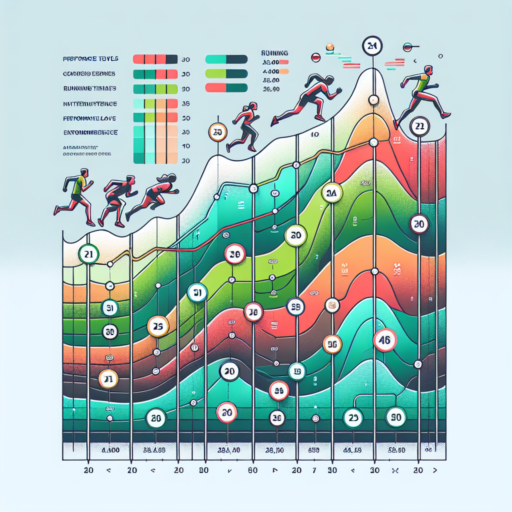What is a Running Power Watts Chart?
A Running Power Watts Chart is a tool that athletes and running enthusiasts use to measure and analyze their running power or effort in terms of watts. This chart provides a visual representation that correlates the runner’s speed, grade of incline, and running efficiency with the power output in watts. Understanding these metrics is crucial for runners aiming to optimize their performance and training regimens.
The chart typically plots the runner’s power output on the vertical axis against time or distance on the horizontal axis. By doing so, it offers insights into how consistently a runner is able to maintain their effort across different terrains or speeds. It’s especially useful for long-distance runners and triathletes who need to pace their energy expenditure throughout an event to avoid burning out too early.
Additionally, using a Running Power Watts Chart can help in setting more accurate training goals. By analyzing past performances, runners can identify specific areas where improvements can be made – be it in speed, endurance, or energy efficiency. Moreover, it serves as a feedback mechanism when trying new training techniques or adjusting running form.
The Importance of Measuring Power in Running
Understanding the significance of measuring power in running is crucial for athletes looking to optimize their performance. Power measurement, traditionally associated with cycling, has found its vital role in the world of running. It offers a more intricate insight into the runner’s efforts than what pace or heart rate data alone can provide. By measuring how much force a runner exerts against the ground and how efficiently this force is applied, athletes and coaches can gain a better understanding of performance dynamics.
One key aspect of measuring power in running is its ability to provide instantaneous feedback. Unlike pace, which can be influenced by elevation changes, wind, and other environmental factors, power output remains a consistent and reliable metric under varied conditions. This allows runners to maintain the correct effort level during training and racing, even when external conditions change. As such, training based on power metrics can lead to more precise control over intensity levels and workload distribution.
Moreover, assessing power output helps in identifying strengths and weaknesses in a runner’s form and efficiency. For example, a discrepancy in power output between legs can reveal imbalances that may not be evident through other means of measurement. By addressing these imbalances, runners can reduce their risk of injury and improve overall performance. Additionally, power data can guide runners in optimizing their race strategy by evaluating how different pacing strategies affect their power output and fatigue levels.
Understanding Watts: A Deep Dive
When it comes to understanding electrical power, understanding watts is fundamental. This unit of measurement is central to how we quantify the rate of energy transfer in devices ranging from household appliances to industrial machinery. But what exactly are watts, and why do they matter so much in our daily lives and technological applications?
At its core, a watt quantifies how much work is done or energy is transferred per unit of time. This concept is vital not just for physicists but for anyone looking to manage energy consumption effectively. Whether you’re calculating the energy use of a light bulb or sizing a generator for your home, watts provide a direct measure of power that impacts efficiency, cost, and environmental footprint.
Moreover, the understanding of watts extends into more practical domains, such as estimating utility bills or configuring renewable energy systems. It allows consumers and professionals alike to make informed decisions about energy use, conservation, and sustainability. In essence, watts symbolize the bridge between theoretical physics and real-world applications, enabling us to harness and manage energy in ways that were unimaginable just a century ago.
How to Read a Running Power Watts Chart
Understanding a Running Power Watts Chart is essential for runners who are keen on optimizing their training sessions and improving performance. This chart displays your power output in watts during a run, offering valuable insights into your efficiency and endurance. To effectively read this chart, it’s crucial to grasp the meaning of the key data points and how they interact with each other.
Identifying Key Metrics
The first step in reading a Running Power Watts Chart is identifying the key metrics. These include your average power, which reflects your overall performance, and your peak power, highlighting your maximum output during the run. Also, pay attention to the power zones, denoted in different colors, representing various intensity levels from low to high. Recognizing these zones helps in planning training intensity based on specific goals.
Understanding the Significance of Fluctuations
Fluctuations in power output can reveal a lot about your running efficiency. Consistent power readings throughout a run indicate efficient energy use, whereas frequent spikes and dips suggest varying effort levels, which might point to an unsteady pace or terrain challenges. Analyzing these patterns allows for adjustments in training to smooth out effort levels for better endurance and speed.
Lastly, comparing your power output over time can offer insights into your progress. Incremental increases in average power in conjunction with training adaptations suggest improvements in running efficiency and strength. Conversely, a plateau or decline in power could signal overtraining or insufficient recovery time. Thus, consistently monitoring and interpreting your Running Power Watts Chart is pivotal for long-term development and achieving peak running performance.
Top Benefits of Using a Power Watts Chart for Runners
Enhanced Training Precision
One of the primary benefits of using a Power Watts Chart for runners is the significant enhancement in training precision. This tool allows athletes to gauge their exact output in real-time, providing a clear metric beyond just pace or heart rate. It enables a more calculated approach to training intensity, ensuring that every run is optimally aligned with their fitness goals.
Improved Performance Analysis
A Power Watts Chart offers detailed insights into a runner’s performance. By analyzing power output over different terrains and speeds, runners can identify specific areas that require improvement. This data-driven approach to evaluation helps in developing targeted training plans tailored to strengthen weaknesses, making it an indispensable tool for any serious athlete looking to elevate their performance.
Customized Training Plans
The adaptability of training plans is another significant advantage of incorporating a Power Watts Chart into a runner’s regimen. By understanding individual power zones, runners can customize their workouts to focus on enhancing endurance, speed, or power. This level of customization ensures that the training is highly effective and aligned with the runner’s personal objectives and current fitness level, making every session count.
No se han encontrado productos.
Comparing Running Power Watts Across Different Athletes
When it comes to comparing running power watts across different athletes, understanding the nuances is key. Running power wattage, a measure of an athlete’s exertion level, can significantly vary depending on various factors such as age, gender, fitness level, and even the terrain where the training or competition takes place. This metric helps in evaluating the efficiency and performance of runners, enabling a more tailored training regimen.
Differences in running efficiency and biomechanics play a crucial role in how power is generated and utilized during a run. For instance, elite runners often showcase higher running efficiency, translating into better power output for the same effort compared to amateur athletes. Moreover, the influence of specific training practices and recovery protocols cannot be understated, as these directly impact the development of an athlete’s running power over time.
Additionally, technology has significantly advanced the accuracy of measuring and comparing running power watts across athletes. With wearables and sophisticated devices, athletes and coaches can now analyze power data in real time, adjusting strategies to improve performance. This brings a new dimension to understanding the critical differences among athletes, guiding training methods, and ultimately, enhancing athletic achievement.
Integrating Running Power Watts Chart into Your Training Regimen
Integrating a Running Power Watts Chart into your training regimen can be a game changer for athletes seeking to optimize their performance. By utilizing this chart, runners can gain insight into their power output, allowing them to adjust their training intensity and duration more effectively. This-focused approach facilitates a deeper understanding of how different terrains, running speeds, and fatigue levels impact your overall energy expenditure.
The concept of measuring running power in watts offers a more quantifiable measure of effort compared to traditional metrics like pace or heart rate. This metric allows for a more precise alignment of training efforts with performance goals. For instance, by analyzing the power output across various segments of a run, athletes can identify specific areas of strength and weakness. This immediately opens the door to targeted improvements, whether it’s enhancing endurance or boosting speed on uphill sections.
Implementing a Running Power Watts Chart into your training demands an understanding of how to read and interpret the data it provides. Key to this is recognizing the correlation between wattage output and running efficiency. Higher watts can indicate more power behind each stride but also necessitate greater energy expenditure. Therefore, finding a balance that optimizes power output without leading to excessive fatigue is crucial for long-term improvement and success in running endeavors.
Advanced Tips for Interpreting Your Power Data
Interpreting power data goes beyond just looking at numbers on a screen. It involves an in-depth analysis and understanding of what those numbers represent and how they affect your performance. By mastering the interpretation of your power data, you can unlock insights that lead to significant improvements in your training and competitive outcomes.
Identify Patterns Over Time
One of the keys to successfully interpreting power data is to look for patterns over time. Instead of focusing solely on single rides, compile your data over weeks or months. This approach allows you to identify trends, such as improvements in your Functional Threshold Power (FTP) or increases in your power-to-weight ratio. By recognizing these patterns, you can adjust your training to focus on areas that need improvement or to continue to build on your strengths.
Analyze Power Distribution
Another important aspect of power data analysis is understanding the distribution of your power output during rides. This involves examining the variability index, which compares your normalized power (NP) to your average power (AP). A lower variability index indicates a more steady effort, which is often ideal for time trials or triathlons. On the other hand, a higher variability index may reflect the dynamic nature of road racing or mountain biking, requiring different training strategies.
Understanding and interpreting your power data using these advanced tips can significantly enhance your training and racing strategies. By focusing not just on the raw data, but also on the patterns and distributions behind them, you can make informed decisions to boost your performance to new heights.
Frequently Asked Questions About Running Power and Watts
When exploring the intersection of running power and watts, many athletes and enthusiasts frequently encounter a myriad of questions. Running with power meters has become increasingly popular as runners of all levels seek to enhance their performance through precise, data-driven insights. Below, we unravel some of the most commonly asked questions to shed light on the crucial elements of understanding running power and watts.
What exactly is running power?
Running power is a metric measured in watts that quantifies the amount of effort a runner exerts to maintain a certain pace or overcome resistance (such as hills or headwind). Unlike traditional metrics like pace or heart rate, running power offers immediate feedback on your performance, making it easier to adjust effort in real-time and maintain optimal efficiency.
How do running power meters work?
Running power meters calculate your effort using various sensors and algorithms. These devices may be embedded in wearables like watches or attached to equipment like shoe pods. They analyze your speed, cadence, and the amount of force applied against the ground to estimate the watts you’re generating. This allows for a comprehensive view of your running dynamics, providing insights beyond what heart rate or pace alone can offer.
Why is the measurement of watts important for runners?
Measuring watts can revolutionize a runner’s training and racing strategy. It provides a direct measure of exercise intensity, unaffected by external conditions or physiological factors like fatigue or dehydration. By focusing on watts, runners can more precisely target training zones, monitor progress, and ensure that they are not over or under-training. Furthermore, understanding and applying this metric can significantly aid in pacing strategies for races or long runs, leading to improved performance outcomes.
The Future of Running Analytics: Beyond the Power Watts Chart
The evolution of running analytics is on the verge of transcending traditional metrics, aiming to offer a more personalized and insightful approach to understanding performance. As we move beyond the power watts chart, a staple in evaluating running efficiency, the industry is gearing towards a sophisticated integration of biometric data, environmental factors, and advanced AI algorithms. This shift promises a holistic view of an athlete’s capabilities, influenced not just by power output but by the nuances of human physiology and external conditions.
In the vanguard of this evolution, new technologies are being developed to assess an athlete’s form and biomechanics in real time. Unlike the static power watts chart, these tools focus on dynamic metrics such as stride length, ground contact time, and asymmetry in movements. By closely monitoring these parameters, runners can receive instantaneous feedback on their form, helping them to adjust their technique on the fly and potentially reduce the risk of injury. This level of analysis, powered by wearable technology, signifies a leap towards preventing performance plateauing and enhancing recovery strategies.
Furthermore, environment adaptation analytics are taking precedence, recognizing the impact of weather, altitude, and terrain on running efficiency. Tailoring training to these variables allows for a more adaptive approach, optimizing performance under varied conditions. Such advancements are facilitated by the integration of GPS and weather data with personalized training algorithms, creating a training regime that prepares athletes for the specific challenges they will face in their competitions. The future of running analytics will not only highlight where an athlete is today but pave the way for where they can go tomorrow, transforming the archetypal power watts chart into a narrative of personal growth and achievement.




